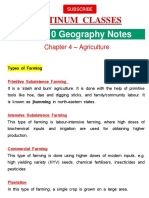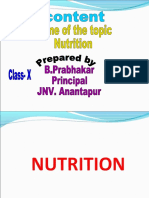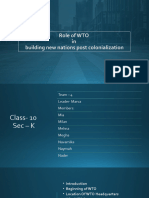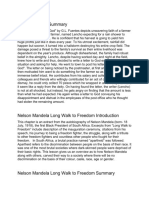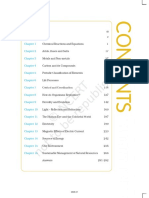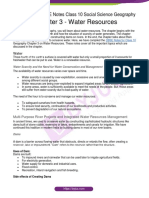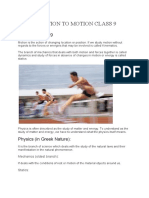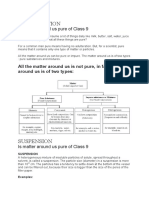100%(1)100% found this document useful (1 vote) 4K views22 pagesConservation and Judicious Use of Natural Resources
Copyright
© © All Rights Reserved
We take content rights seriously. If you suspect this is your content,
claim it here.
Available Formats
Download as PDF or read online on Scribd
nce Honk WO
oA project teport on
"Conerotion and judicious
use ji natural wesouces
, he i +;
it fry { ae #
a ac Me sen’ at�re
Certificate
This is to certify that Mr.Naveen
Prajapati of class 10" of St. Joseph's
School has successfully carried out the
science project entitled Conservation
and judicious use of natural
resources. Under the supervision of
Mr.Saurabh Baranwal for the academic
year of 2020-21. All the work related to
project is done by candidate himself.
The report is found worthy of
i acceptance as final project report for
the subject Science of class 10".
BS
Principal. Head of department
pee
sen�Acknowledgement
| wish to express my deepest gratitude
and sincere thanks to the principal Mrs.
Jaswinder _ Kaur.St.Joseph’s School,
Bhatpar Rani for his encouragement and
for all the facilities that he provided me in
this project work. | sincerely appreciate
this magnanimity by taking me into his
fold for which | shall here in indebted to
him. | extent my hearty thanks to
SCIENCE teacher Mr.Saurabh Barnwal
,who guided me to successful completion
of this project. | take this opportunity to
express my deep sense of
gratitude,attitude and immense
motivation which has sustained my effort
at all the stages of this project work.�Conservation and judicious use of
natural resources
Natural resources are conserved for their biological,
economic and recreational values. The use of natural
Tesources in excess and unplanned way leads to imbalance
in the environment. A judicious balance should be
maintained between exploitation of resources and its
replenishment. Proper utilization and management of
nature and its resources is termed as conservation.
We have to build a sustainable world, which should last
forever. Some of the ways to sustain continuous use of
resources are practices to utilise energy efficiently, avold
wastage of water, avoid usage of plastics and other non-
biodegradable materials and to take care for the
environment we live. It is important that we manage and
use our resources carefully so as to preserve for the future
generations.
Forest and it’s importance
Forests are an important component of our environment
and are dominated by microorganisms, flowering plants,
shrubs, climbers, dense trees and provide a vast habitat for
wild animals. Forests also contribute to the economic�development of our country. Forests are vital for human
life, it is a source for a wide range of renewable natural
tesource. They provide wood, food, fodder, fibre and
medicine.
Forests are major factor of environmental concern. They
act as carbon sink, regulate climatic conditions, increase
rainfall, reduce global warming, prevent natural hazards
like flood and landslides, protect wildlife and also act as
catchments for water conservation. They also play a vital
role in maintaining the ecological balance
1.Deforestation and its Effects
Deforestation is the destruction of large area of forests.
This happens for many reasons like intensive agriculture,
urbanization, construction of dams, roads, buildings and
industries, hydroelectric projects, forest fires, construction
of mountain and forest roads. It is a threat to the economy,
quality of life and future of the environment. India is losing.
about 1.5 million hectares of forest cover every year.
Effects of Deforestation
Deforestation gives rise to ecological problems like floods,
drought, soil erosion, loss of wild life, extinction of�species, imbalance of blogeochemical cycles, alteration of
climatic conditions and desertification.
2. Conservation of Forests
India has an area of 752.3 lakh hectare classified as
reserved forests and 215.1 lakh hectare as protected
forests, The important measures taken for conservation
of forests are as follows
Afforestation: Activities for afforestation programme
(Van Mahotsav) includes planting and protecting trees
with multiple uses which help in restoration of green cover.
Destruction of trees should be curtailed.
Social forestry programme: It should be undertaken
ona large scale with active participation of the public and
utilization of common land to produce firewood, fodder
and timber for the benefit of the rural community. This
relieves pressure on existing forests and to safeguard
future of tribals.
@-Forest Conservation “through Laws: Adopting
stringent laws and policies to conserve and protect forests
are through National Forest Policy, (1952 and 1988) and
Forest Conservation Act, 1980.
‘SeannadithCamScaner�Wildlife and its Conservation
Wild life refers to the undomesticated animals living in
their natural habitats (forests, grasslands and deserts) an
area without human habitation. They are needed for
Maintaining biological diversity. It also helps in promoting
economic activities that generates revenue through
tourism. Conservation of forest and wildlife is interrelated
with each other.
1.Decline in Wildlife Population
Wildlife of india is a great natural heritage. Exploitation of
wildlife resources has decreased global wildlife population
by 52% between 1970 and 2014. Over exploitation and
shrinking of forest cover areas has resulted in animals
becoming extinct, some are threatened and some are on
the verge of extinction. In recent years, increase in human
encroachment has posed a threat to India’s wildlife.
2. Aims of Wildlife Management
The main aim of wildlife conservation are
© To control and limit exploitation of species.
* To preserve the plants and animals from extinction.
* Hunting and poaching should be prohibited.�ey
© Establishment of National parks, Wildlife sanctuaries,
cted areas and Biosphere reserves.
prote
was established in 1972.
© The Wildlife protection Act
The provisions of the act are
© Prohibit killing and hunting of specified animals.
© Constitute sanctuaries, national parks, and closed
areas for wildlife conservation.
* Special schemes for preservation of endangered
species.
© Constitute Central Zoo Authority and recognition of
z00s.
© Restrict, regulate or prohibit trade in wild animals and
products obtained from them
3,4,Organisation Involved in Conservation
of Wildlife
e Indian Board for WildLife (IBWL).
¢ World Wildlife Fund (WWF) for Nature
¢ World Conservation Union (WCN).
¢ International Union for Conservation of Nature and
Natural resources (IUCN).
¢ Convention of International Trade in Endangered
Species (CITES).�Soil Erosion
The top layers of soll contain humus and mineral salts,
which are vital for the growth of plants. Removal of upper
layer of soll by wind and water is called soil erosion. Soil
erosion causes a significant loss of humus, nutrients and
decrease the fertility of soil
1. Agents of Soil Erosion
Agents of soil erosion are high velocity of wind, air
currents, flowing water, landslide, human activities
(deforestation, farming and mining) and overgrazing by
cattle.
2.Management of Soil Erosion
Retain vegetation cover, so that soil is not exposed.
Cattle grazing should be controlled.
* Crop rotation and soil management improve soil
organic matter.
‘« Runoff water shauld be stored in the catchment.
« Reforestation, terracing and contour ploughing.
* Wind speed can be controlled by planting trees in
form of a shelter belt.�Renewable_and_Non-Renewable Energy
Resources
Energy is an important input for development. The
€xpansion of possible energy resources has been directly
telated with the pace of agricultural and industrial
development in every part of the world. Energy resources
can be classified as non-renewable and renewable.
Non-renewable _(Exhaustible) ener;
resources
Energy obtained from sources that cannot renew
themselves over a short period of time is known as non-
renewable energy. These are available in limited amount in
nature. They include coal, petroleum, natural gas and
nuclear power. These conventional energy resources
account for 90% of the world’s production of commercial
energy and nuclear power account for 10%.
Renewable Inexhaustible ener;
resources-
These energy resources are available in unlimited amount
in nature and they can be renewed over a short period of
‘SeannadithCamScanner�time, inexpensive and can be harvested continuously.
These comprise the vast potential of non-conventional
energy resources which include biofuel, biomass energy,
Beothermal energy, water energy (hydroelectric energy
and tidal energy), solar energy, wave energy and wind
energy.
1L.Fossil Fuels
Fossil fuels are found inside the earth’s crust and are
energy rich substances formed by natural process, such as
anaerobic decomposition of buried dead organisms, over
ns of years. As the accumulating sediment layers
produce heat and pressure, the remains of the organisms
are gradually transformed into hydrocarbons. Eg.
petroleum, coal and natural gas.
2,Coal and Petroleum
Coal and Petroleum are natural resources. They are called
fossil fuels as they are formed from the degradation of
biomass buried deep under the earth millions of years ago.
Coal is used for generation of electricity at Thermal power
plants, Petroleum also known as crude oil is processed in
oll refineries to produce petral and diesel which are used
‘SeannadithCamScanner�to run automobiles, trucks, trains, ships and airplanes etc.
Kerosene and LPG (Liquefied Petroleum Gas) obtained
from petroleum is used as domestic fuel for cooking food.
The coal and petroleum reserves can get exhausted if we
Continue using them at a rapid rate. The formation of these
fossil fuels is a very slow process and takes very long period
of time for renewal.
3,Steps to Conserve Coal and Petroleum
>Resources
It is necessary to conserve or save coal and petroleum
resources for the future use, which can be done by
reducing their consumption.
If electricity is saved, it will inturn reduce the use of coal.
2.Using bicycle for covering short distances instead of
using cars, scooters or motorcycles
3.Using pressure cooker can reduce the consumption of
kerosene and LPG while cooking food. Solar cooker and
solar heaters can be used wherever possible.
4.Motor vehicles should be designed with fuel efficient
engines to increase efficiency and also reduce air pollution.
‘SeannadithCamScanner�Non-Conventional (Alternative)_Energy
Resources
The energy crisis has shown that for sustainable
development in energy sector we must conserve the non-
renewable conventional resources from its rapid depletion
and replace them by non-polluting, renewable sources
which are environmentally clean.
Efforts are made to develop new sources of energy which
is called non-conventional sources of energy. It would
provide greater initiative to local people who could assess
their needs and resources and plan a strategy that could
be useful to them.
1.Solar Energy
Solar energy is the energy obtained from the sun. The
sun gives out vast amount of light and heat. It is only a little
less than half (47%) of solar energy which falls on the
atmosphere reaches the earth’s surface. If we could use just
a small part of this energy it would fulfill all the country’s
need for power. Solar energy has advantages and also
certain limitations,�Solar Energy Devices
The energy from the sun ca
Power, The various devices
energy are called solar energy devices.
in be harnessed to provide
used for harnessing sun’s
Solar Cells
Solar cells (Photovoltaic devices) is made up of silicon that
converts sunlight directly into electricity. Solar cell produces
electricity without polluting the environment. Since it uses
no fuel other than sunlight, no harmful gases, no burning
and no wastes are produced. These can be installed in
remote and inacessible areas (forests and hilly regions)
where setting up of power plant is expensive.
Use of solar cells
It can be used for street lighting, traffic signals, water
pumping, battery charging system etc.
¢ It is used in artificial satellites and space probes.
© It provides radio and TV transmission to remote areas
‘Seannadith Camscanner�Soe
alan Thermal Fesustn Plonfe
Salen Tama Fawn Blan
Solar Panel
Arrangement of many solar cells side by side connected to
ach other is called solar Panel. The capacity to provide
Clectric cuurent is much increased in the solar panel, But
the process of manufacture is very expensive.
Solar Cooker
{consis of an insulated metal box or wooden box which is
Painted from inside so as to absorb maximum solar
radiations. A thick glass sheet forms the cover over the box.
The reflector is the plane mirror which is attached to the
box. The food is cooked by energy radiated by the sun
Solar thermal power plant
'n solar thermal power plants, many solar panels are used
to concentrate sun rays, to heat up water into steam. The
steam is used to run the turbines to produce electricity.
Advantages of Solar Ene:
* itis available in abundance in our country and is free
of cost.
© Itisa renewable source of ‘energy.
* Itcan be used for generating electricity or heat.
z
5
8�© It does not cause pollution.
2Blogas
Biogas Is the mixture of methane (nearly 75 %), hydrogen
Sulphide, carbon dioxide and hydrogen. It is produced by
the decomposition of animal wastes (cow dung) and plant
wastes in the absence of oxygen. It is also commonly called
as ‘Gobar gas’ since the starting material used is cow dung
which means gobar in Hindi.
Uses of biogas
© Itis used as fuel for cooking .
* It is used to run motors and pump sets.
© Itis used to generate electricity.
3.Wind Eneray
The kinetic energy possessed by the wind is due to its high
speed, that can be converted into mechanical power by
wind turbines. The wind energy can be used for (i)
generating electricity (il) Run water pumps, flour mills etc.
(iil) Rotatory motion ‘of windmill is used to draw water; from
wells.
Windmill�Windmill is a machine that converts the energy of wind into
‘otational energy by broad blade attached to the rotating
axis. When the blowing air strikes the blades of the
Windmill, it exerts force and causes the blades to rotate.
The rotational movement of the blades operate the
generator and the electricity is produced. The energy
output from each windmill is coupled together to get
electricity on a commercial scale.
Advantages of Wind eneray
* Wind energy is free, eco-friendly, renewable source of
energy.
* Does not cause pollution.
‘+ Expenses on periodic maintenance is low.
4.Water Energy
Earth’s surface is covered with nearly 71% of water.
Harnessing the energy from the flowing water can be used
to produce electricity. The technique to harness the water
energy is called Hydropower.
The electrical energy is derived from water flow, water
falling from a height. Hilly areas are suitable for this
purpose where there is continous flow of water in large�mounts falling from high slopes. It does not cause
environmental pollution or waste generation.
Hydropower plants converts the kinetic energy of flowing
Water into electricity. This is called hydroelectricity.
S.Tidal Eneray
Tidal energy is the energy obtained from the movement of
water due to ocean tides. Tides are the rise and fall of sea
levels caused by the combined effects of the gravitational
forces exerted on the oceans of the earth.
A tidal stream is a fast flowing body of water created by
tides. Turbines are placed in tidal streams. When the tides
hit the turbine, the turbine rotates and converts the tidal
energy into electric energy.
Rainwater Harvestin
Rainwater harvesting is a technique of collecting and
storing rainwater for future use. It is a traditional method
of storing rain water in underground tanks, ponds, lakes,
check dams and used in future.
The main purpose of rainwater harvesting is to make the
rainwater percolate under the ground so as to recharge
“groundwater level’.
‘SeannadithCamScanner�Methods of rainwater harvesting
* Roof top rainwater harvesting: Roof-tops are excellent
rain catchers. The rain water that falls on the roof of
the houses, apartments, commercial buildings etc. is
collected and stored in the surface tank and can be
used for domestic purpose.
© Recharge pit: In this method, the rainwater is first
collected from the roof tops or open spaces and is
directed into the percolation pits through pipes for
filtration. After filtration the rainwater enters the
recharge pits or ground wells.
People living in rural areas adopt a variety of water
collecting methods to capture and store as rain water.
Some of the methods used are
* Digging of tanks or lakes (Eris): It is one of the
traditional water harvesting system in Tamil Nadu. Eris
are constructed in such a way that if the water in one
eri overflows, it automatically gets diverted to the eri
of the next village, as these eris are interconnected.
© Qorains: These are small ponds to collect rainwater.
The water is used for various domestic purposes
(drinking, washing and bathing). These ponds cater the
nearby villages�— ~
44> ge cw
soil &
seb
Bead xeake Management
Advantages of rainwater harvesting
Rainwater harvesting helps to
* Overcome the rapid depletion of ground water
levels.
* To Meet the increase demand of water.
‘* Reduces flood and soil erosion
* Water stored in ground is not contaminated by
‘human and animal wastes and hence can be used
Solid Waste Management
Solid wastes mainly include municipal wastes, hospital
Wastes, industrial wastes and e-wastes etc. The solid
wastes are dumped in the soil which results in landscape
pollution.
Solid- waste management involves the collection,
treatment and proper disposing of solid material that is
discarded from the household and industrial activities.
Methods of solid wastes disposal
« Segregation: It is the separation of different type of
waste materials like biodegradable and non
biodegradable wastes.�+ Sanitary landfill: solid wastes are dumped into low
lying areas, The layers are compacted by trucks to
allow settlement. The waste materials get stabilised In
about 2-12 months. The organic matter undergoes
decomposition.
« Incineration: It Is the burning of no!
solid wastes (medical wastes) In properly
furnances at high temperature.
« Composting: Biodegradable matter of solid wastes
is digested by microbial action or earthworms and
converted into humus.
Recycling of wastes
n-blodegradable
constructed
Papers from old books, magazines and newspapers are
recycled to produce papers in papermills.
Agricultural wastes like coconut shells, jute cotton stalk,
bagasse of sugarcane can be used to make paper and hard
board. Paddy husk can be used as livestock fodder.
Cowdung and other organic wastes can be used in gobar
gas plant to provide biogas and manure for fields.
3R Approach�cae eorecre re ene ee
The 3R approach such as Reduce,
be followed for effective waste ma
Points to Remember
Reuse and Recycle may (
Inagement.
Conservation is a process which is concerned with the use,
Preservation and proper management of natural resources
from destructive activities of human being.
* Conservation of natural resources contributes to the
social and economic development of the country.
© Forests of a country constitute a major asset for the
people of the country.
© National park is a reserved area for the conservation
of entire wildlife including plants and animal
© Sanctuary is a place reserved exclusively for the use of
animals.
Solar cell is a device that absorbs sunlight and
converts it into electric energy.
e Solar water heater does not require electricity, they
heat up water directly from sunlight.
© Biogas is produced by the anaerobic decomposition of
cow dung.
© The technique of collecting and storing rain water for
future purpose is known as rainwater hharvesting
‘Seannadith CamScaner






